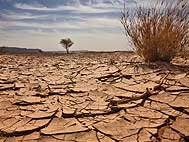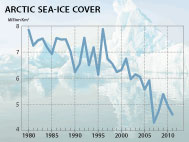| SEARCH |
-

Nov 17, 2015
Reflections on a three-decade legacy
The International Geosphere-Biosphere Programme (IGBP) will come to a close at t...
-
Nov 17, 2015
Use of and access to content on this website
Text and images produced by IGBP in house are free to use with appropriate credi...
-
Nov 12, 2015
Bella Gaia performance and panel discussion to mark IGBP's closure
A musical performance by Bella Gaia will celebrate the achievements and legacy o...
-

Towards Future Earth:
evolution or revolution?
During its three decades of existence, the International Geosphere-Biosphere Pro...
-
A personal note on IGBP and the social sciences
Humans are an integral component of the Earth system as conceptualised by IGBP. João Morais recalls key milestones in IGBP’s engagement with the social sciences and offers some words of advice for Future Earth.
-
IGBP and Earth observation:
a co-evolution
The iconic images of Earth beamed back by the earliest spacecraft helped to galvanise interest in our planet’s environment. The subsequent evolution and development of satellites for Earth observation has been intricately linked with that of IGBP and other global-change research programmes, write Jack Kaye and Cat Downy .
-
Deltas at risk
Around 500 million people worldwide live on deltas, but many of the world's deltas are sinking due ...
-
Climate change: the state of the science
A new data visualization released on the first day of the plenary negotiations at the UNFCCC’s clima...
-
Climate Change:
the State of the Science
Videos now online from the Stockholm public forum to mark the launch of the IPCC's climate report, 2...

photo: Erik Huss
First published in IGBP's Global Change magazine 84, November 2015
A personal note on IGBP and the social sciences
Humans are an integral component of the Earth system as conceptualised by IGBP. João Morais recalls key milestones in IGBP’s engagement with the social sciences and offers some words of advice for Future Earth.
João Manuel F de Morais is a Senior Research Advisor at the Swedish International Development Cooperation Agency in Stockholm, Sweden. He joined IGBP in 1995 and was the Deputy Director, Social Sciences, from 1996 to 2012.
In the first volume of his autobiography published in 1952, the Hungarian‑British author and journalist Arthur Koestler wrote of a revolutionary crisis that was rapidly demolishing all familiar assumptions of thought. Having lived through major historical convulsions associated with the pre- and post-world wars, Koestler – who was briefly a science editor during his writing career – pondered whether the state of matter, and of life, ultimately, would converge. As he wrote, “Philosophy is the gaseous state of thought, Science its liquid state, Religion its rigid state.”
The meteoric path of global-change research represents Koestler’s convergence. The seeds of this research were sown by the race to put a man on the moon in the 1960s, a development that was as political as it was technical. The era of space exploration provided a philosophically as well as visually powerful porthole to our blue planet. Seeing the planet as a whole highlighted its fragility and hence the necessity of some kind of governability. Perhaps that is why the term “global change” emerged in the 1970s from the political-science community. This term would soon be superseded by “Earth-system science”, best illustrated by the so-called Bretherton diagram that was developed in 1986 for a NASA advisory council report (1).
Humans occupied a marginal position in the geocentric Bretherton world. But despite such marginalisation, this conceptualisation of the planet and its functions spoke to the plea for a human agenda to address “our common future” (2). Perhaps under the sway of this ideal, IGBP initially flirted with normative issues such as governance, commonly associated with the social sciences. But IGBP also saw itself as a “neutral forum”: its leadership pointed out that the Human Dimensions Programme – which at the time represented the social-science research relevant to global change – was closely related to policy and that IGBP should “avoid being drawn into politics” (3).
I joined IGBP in 1995 initially as the Social Sciences Officer, after having been involved with human and natural science studies as an archaeologist. I soon realised, with much disappointment, that global-change research in fact reflected parallel scientific worlds. There was even a “social process diagram” designed to match its Bretherton counterpart (4) and, for a short time, duplicate HDP offices in Barcelona and Geneva, reminding us of the Avignon versus Rome papal schism. I was nevertheless encouraged by the opportunity that the IGBP agenda offered to challenge the two-culture syndrome, particularly through projects such as Past Global Changes (PAGES) and Land Use and Cover Change (LUCC). The work of these projects clearly demonstrated how biogeochemistry, climate and land-cover change have interacted with the human sphere in space and time. I was keen to do more.
My opportunity came when the International Council for Science (ICSU) and the International Social Science Council (ISSC) – sponsors of IGBP and the Human Dimensions Programme, respectively – initiated closer collaboration. In 1996, I participated in exciting discussions in which two opposing views emerged: one camp argued for integrating both programmes under the IGBP umbrella while the other wanted to group the human sciences into a separate programme. Unfortunately, the timing wasn’t ripe to allow those two asymmetrical communities to merge. A separate programme, the International Human Dimensions Programme on Global Environmental Change (IHDP), was set up after substantial effort and negotiations. I recall a critical dinner where ICSU General Secretary J W M La Rivière, Eckart Ehlers and I brainstormed on how IHDP could have a home at the University of Bonn, where Ehlers was Professor of Geography.
Despite the missed opportunity to integrate, some IGBP communities and its Secretariat strove hard to better incorporate the social sciences into the research agenda and find the required administrative infrastructure to run it. For example, the LUCC project engaged a broad community involving natural and social sciences. As Ola Uhrqvist notes, (5) this endeavour was not without its tensions: it wasn’t always easy to reconcile different methodologies and perceptions of scales. Nevertheless, he states, “the project added new layers of complexity and non-linearity to IGBP’s and IHDP’s Earth System imaginary.” And, like finding a home for IHDP, it took many negotiations and steadfast commitment from IGBP to have a core project office established at the Cartographic Institute in Barcelona.
Such developments helped cement the place of humans as integral components of the Earth system. Throughout the late 1990s, IGBP and its community were becoming more and more aware of the need for integration of the natural and social sciences. IGBP thus took the lead in organising the seminal Amsterdam open science conference in 2001, which was held jointly with the other global-change programmes. This would prove to be the trigger to set up the Earth System Science Partnership (ESSP). If, in its early phases, global change research suffered from an obvious attraction and bias in which Earth system’s biophysical processes were seen as having a better “fit” at a global scale, the ESSP platform helped the science to come of age. ESSP raised awareness that global impacts on life-supporting systems and livelihoods were most critical at sub-global levels, where societal needs reside.
Based on my 17-year history with IGBP, I do not hesitate to underscore the critical role this programme played in advancing scientific integration and cross-disciplinary leadership, a fact that unfortunately finds little mention in a recent overview of the history of global-change research (6). Had it not been so, concepts such as the Anthropocene, the Great Acceleration and global-regional integration would not have emerged as such central themes of IGBP’s first synthesis. In the past decade or so, IGBP’s projects such as the Global Land Project and Land-Ocean Interactions in the Coastal Zone (co-sponsored by IHDP) have ensured a continuing and vital role for the social sciences. In many ways, IGBP’s trajectory over the past decade has set a strong foundation for Future Earth.


On Future Earth
The Future Earth scientific agenda and its broad leadership indicate the recognition of the common interests bridging science and society. However, we seem to have made little progress in bridging regional divides. Whereas the power of international partnerships has received much attention, the more modest but valuable place-based research done in the developing world (see page 14 of this issue) tends to escape attention. Regrettably, making headway into unravelling the carbon cycle seems easier than conducting science that is participative and based on a shared global responsibility. But a real push towards global sustainability can only be achieved by overcoming the “us” and “them” of separate or incompatible worldviews and agendas. The minutes of early IGBP Scientific Committee meetings suggest that there was, from the outset, the desire to see a strong regional presence via regional research centres and national committees. Whereas some progress was made, scarce resources meant that many of these remained mere platforms and fora for presentations on IGBP and geo-biosphere observatories. In spite of geopolitical interests that led to the establishment of regional networks in Africa, Latin America and Asia, such initiatives had (and arguably still have) poor articulation within the global-change programmes’ priorities. Future Earth should do better.

References
1. Earth System Science Overview: A Program for Global Change. Earth System Science Committee, NASA Advisory Council, 1986.
2. WCED (1987) Our Common Future: Report of the World Commission on Environment and Development. Switzerland.
3. Minutes of the fourth IGBP Scientific Committee meeting. Munich and Rosenheim, Germany, 1992.
4. Pathways of Understanding: The Interactions of Humanity and Global Environmental Change. Consortium for International Earth System Science Information Network (CIESIN), Michigan, USA, 1992.
5. Uhrqvist O (2014) Seeing and knowing the Earth as a system: an effective history of global environmental change research as scientific and political practice. PhD thesis. Linköping University. http://urn.kb.se/resolve?urn=urn:nbn:se:liu:diva-110654
6. Mooney H, Duraiappah A and Larigauderie A (2013) Proceedings of the National Academy of Sciences 110: 3665-3672, doi: 10.1073/pnas.1107484110
IGBP closed at the end of 2015. This website is no longer updated.
-

Global Change Magazine No. 84
This final issue of the magazine takes stock of IGBP’s scientific and institutional accomplishments as well as its contributions to policy and capacity building. It features interviews of several past...
-

Global Change Magazine No. 83
This issue features a special section on carbon. You can read about peak greenhouse-gas emissions in China, the mitigation of black carbon emissions and the effect of the 2010-2011 La Niña event on gl...
-
INTERGOVERNMENTAL PANEL ON CLIMATE CHANGE:
How green is my future?
UN panel foresees big growth in renewable energy, but policies will dictate just how big.
-
UK:
'The Anthropocene: a new epoch of geological time?'
Royal Society, Philosphical Transactions A




















